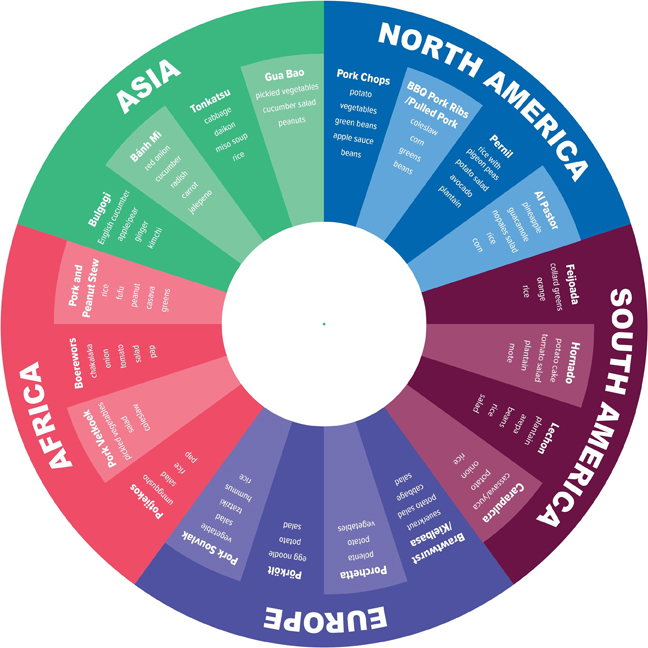There’s a World of Flavor in Pork
July 26, 2024 | 5 min to read
A recent sensory analysis highlights that Pork boasts over 110 unique flavor nuances, revealing its compatibility with various fruits and vegetables. The study shows lean pork, particularly when air-fried, offers intense umami and kokumi sensations, making it a versatile ingredient. Researchers aim to debunk the myth of flavorless lean pork and promote the Pork + Plants World of Flavors Wheel, encouraging culturally relevant recipes that enhance nutrition and flavor without sacrificing enjoyment.

A recent sensory analysis of pork demonstrates over 110 unique flavor nuances that illustrate why it embraces cross-cultural tastes and brings more plants to the plate.
DES MOINES, Iowa – New sensory science research into the optimal flavor compatibility of pork may provide some clues as to why it complements fruits and vegetables so well.1*
A recent sensory analysis shows that pork has more than 110 unique flavor nuances, while pork fat alone has around 30 flavor nuances, highlighting versatility in flavor and texture of cuts and preparation methods. Some of pork’s world of flavors includes sweet, fruity and floral tones, clove, hazelnut and mushrooms. Pork also hits on all the basic flavor characteristics including sweet, salty, acidic and umami.

Scientists looked at the cooking methods that imparted the most flavor to pork, and which cuts had the most intense flavor nuances. Lean pork had the most intense umami flavor compared to other plant and animal proteins, including high fat pork fat. The researchers found the most “juicy” and “sweet” pork cuts included pork tenderloin made in an air fryer and roasted pork roast.
Pork is High in Kokumi
Pork was found to be high in umami and kokumi taste sensations. Kokumi is a Japanese word that translates to a feeling of “rich taste” or “delicious,” and in some cases, it is a sensation that cannot be expressed by the five basic tastes or may even more of a texture sensation, while umami a taste of savoriness or meatiness.
Lead investigator, Lisbeth Ankersen of InnovaConsult, suggests that, “The flavor notes we identified in this analysis, like mushroom, walnut, coconut and clove, are what make pork so unique as a friend to all foods and a uniter of worlds of flavors together.”
Kristen Hicks-Roof, PhD, RDN, LDN, FAND, Director of Human Nutrition for the National Pork Board, suggests this sensory evaluation will encourage new culturally-relevant recipe development and inform optimal cooking methods and food pairings that maximize the nutrition pork brings with it when it’s on the plate.
“This analysis not only lets us pinpoint the best cooking methods to make sure pork’s unique flavor profile shines no matter if a top chef or mom is preparing it, but also gives us a roadmap for pairing plants with pork to make sure eating healthy does not have to be boring and flavorless. Pork can help serve as the flavor vehicle to enhance any dish!,” says Dr. Hicks-Roof.
Putting the Lean Pork is “Flavorless” Myth to Rest
Because of the unique flavors of lean pork compared to pork fat, researchers believe it is time to dispel the myth that lean cuts of pork are “flavorless.” Research chef, Rachel Gooding, CCS, elaborates that, “Lean cuts of pork can be used in a variety of typically bland dishes to impart a wide array of flavors along with increasing the nutrient-density of meals in a flavorful way.”
Gooding adds that, “Putting this research into action — air frying pork was found to lead to “juicy” and “sweet” flavor notes, which makes air fried lean pork cuts, such as tenderloin or sirloin pork chop, a perfect pairing for bitter vegetables or legumes like cooked black or pinto beans, brussels sprouts, green beans or broccoli, with its slight sweet and strong umami notes.”
Nutritionally speaking, every 3-ounce serving of cooked lean pork, such as pork tenderloin, brings more than 20 grams of protein to a recipe.2 Pork tenderloin is an excellent source of vitamins and minerals including thiamin, selenium, niacin, riboflavin, B6 and B12,2 and is a Heart-Check certified food by the American Heart Association.3
Pork + Plants World of Flavors Wheel
“Around the world, pork is a top protein choice, and we tried to illustrate this concept with our new flavor wheel,” says, Dr. Hicks-Roof. “This idea goes beyond nutrition, and deep into cultural and flavor experiences that honor centuries of food heritage and culinary traditions, all while pork acts as a carrier food that encourages us to eat more of the foods we know we should, like fruits and vegetables, in cuisines worldwide,” she explains.
References:
- Ankersen L. Comprehensive sensory and flavor nuances of pork and pork fat. National Pork Board website. https://www.porkcheckoff.org/research/comprehensive-sensory-and-flavor-nuances-of-pork-protein-and-fat/. Published March 22, 2024. Accessed June 26, 2024.
- Pork Tenderloin (FDC ID 168250). FoodData central website. https://fdc.nal.usda.gov/fdc-app.html#/food-details/168250/nutrients. Accessed May 24, 2024.
- Heart-Check Food Certification Program Nutrition Requirements. American Heart Association website. https://www.heart.org/en/healthy-living/company-collaboration/heart-check-certification/heart-check-in-the-grocery-store/heart-check-food-certification-program-nutrition-requirements. Accessed May 24, 2024.
*This analysis was funded by the National Pork Board.
About National Pork Board:
The National Pork Board has responsibility for Pork Checkoff-funded research, promotion and consumer information projects and for communicating with pork producers and the public. The Pork Checkoff funds national and state programs in consumer education and marketing, retail and foodservice marketing, export market promotion, production improvement, science and technology, swine health, pork safety, and environmental management and sustainability. For the past half century, the U.S. pork industry has delivered on its commitment to sustainable production and has made significant strides in reducing the environmental impact of pig farming. Through a legislative national Pork Checkoff, pork producers invest $0.35 for each $100 value of hogs sold. Importers of pork products contribute a like amount, based on a formula. For information on Checkoff-funded programs, pork producers can call the Pork Checkoff Service Center at (800) 456-7675 or visit www.pork.org.
